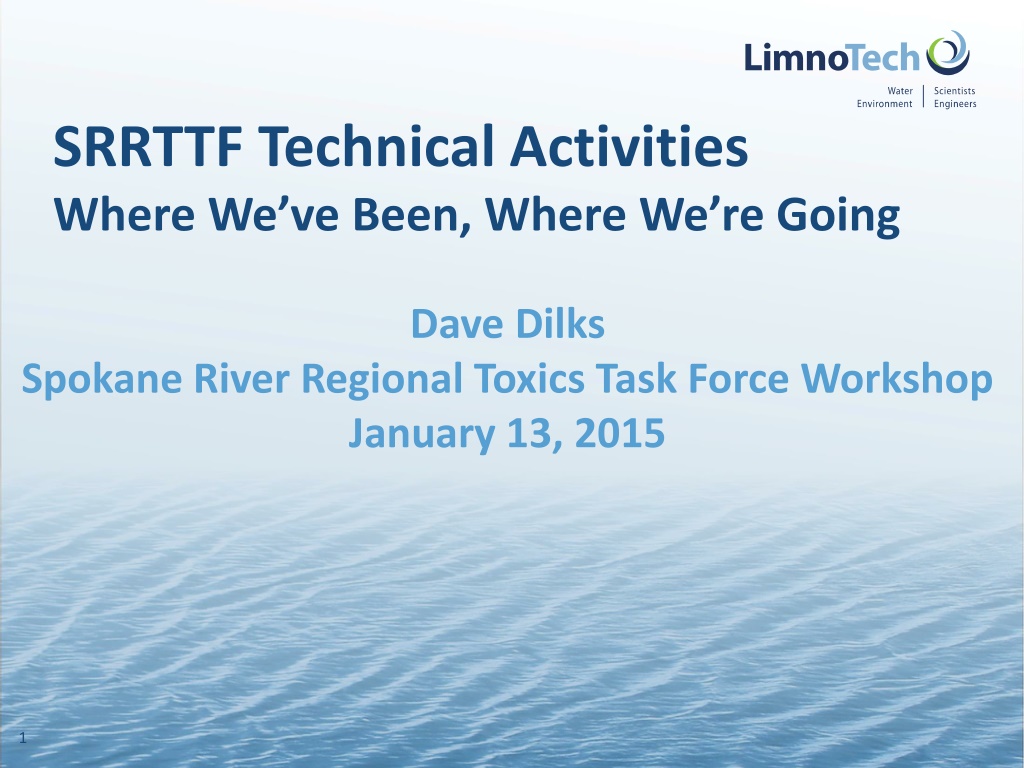Exploring SRRTTF Technical Activities for Spokane River Toxics Task Force
Delve into the technical activities of the Spokane River Regional Toxics Task Force, focusing on objectives, study areas, phasing of activities, and findings from past workshops to understand and address sources of toxics in the Spokane River watershed.
Download Presentation

Please find below an Image/Link to download the presentation.
The content on the website is provided AS IS for your information and personal use only. It may not be sold, licensed, or shared on other websites without obtaining consent from the author. Download presentation by click this link. If you encounter any issues during the download, it is possible that the publisher has removed the file from their server.
E N D
Presentation Transcript
SRRTTF Technical Activities Where We ve Been, Where We re Going Dave Dilks Spokane River Regional Toxics Task Force Workshop January 13, 2015 1
Outline Task Force objectives Where we ve been Where we are Where we re going 2
Objectives: What are We Doing, & Why? Primary Task Force objective Identify and implement appropriate actions needed to make measurable progress towards meeting applicable water quality standards Associated objective Characterize the sources of toxics in the Spokane River 3
Study Area Upper Spokane River Lake Coeur d Alene outlet to headwaters of Lake Spokane 4
Phasing of Technical Activities Phase 1 Gather existing data, identify data gaps December, 2013 workshop Prepare a monitoring plan Phase 2 Collect new data Phase 3 Analyze data and characterize sources Phase 4 Assess potential Best Management Practices and develop a Comprehensive Plan 5
Where Weve Been: Phase 1 Findings A large amount of data had already been collected in the Spokane River watershed Dept. of Ecology (2011) PCB Source Assessment Primary data gaps defined in 2013 Sources contributing to stormwater loads Significance of loading from groundwater sources Significance of loading from atmospheric sources Sources upstream of the Idaho/Washington border 6
Where Weve Been: Phase 1 Findings Conclusions from December 2013 workshop Not feasible to address all gaps at once First year of monitoring should focus on characterizing dry weather sources 7
Phasing of Technical Activities Phase 1 Gather existing data, identify data gaps December, 2013 workshop Prepare a monitoring plan Phase 2 Collect new data Phase 3 Analyze data and characterize sources Phase 4 Assess potential Best Management Practices and develop Comprehensive Plan 8
Phase 1 Monitoring Plan Components Synoptic Study Support mass balance assessment Seasonally Integrated Sampling Provide information on the seasonal variability of loading from Lake Coeur d Alene Confidence Testing Can we expect to get meaningful results from standard grab sampling? 9
Intent of Synoptic Survey Support dry weather mass balance assessment Measure river concentration at flow gaging locations Measure all known dry weather sources Identify unknown sources between each station Unknown source = Downstream load Upstream load Known Load NPDES Permited Location Gauging Station Location Hangman Creek Inland Empire Paper Liberty Lake Coeur d'Alene City of Spokane Spokane County Kaiser Post Falls Hayden Spokane Trent Avenue Bridge Barker Rd. Post Falls Coeur d'Alene Lake Outlet Spokane Gage Trent Avenue Bridge Barker Rd. to Trent Avenue Bridge Post Falls to Barker Rd. Coeur d'Alene Lake Outlet to Post Falls to to Spokane Gage Nine Mile Dam 10
Seasonally Integrated Sampling Provide information on the seasonal variability of loading from Lake Coeur d Alene Spring high flow Summer low flow Winter moderate flow 11
Confidence Testing Determine if meaningful results can be expected from standard grab sampling Conducted in conjunction with seasonally integrated sampling Two locations sampled May 13-19, 2014 12
Confidence Testing Results Concentrations were low (8-80 pg/L) and at similar levels as blanks (8-54 pg/L) Synoptic survey not expected to satisfy objective of supporting a rigorous mass balance assessment 13
Confidence Testing Results River concentrations expected to be higher during summer survey Much lower river flows means much less dilution of PCB sources In-river signal expected to rise above measurement noise Especially as we move downstream 14
Confidence Testing Conclusions Synoptic survey still of value Capable of identifying presence of larger sources Data quality objectives modified Support a semi-quantitative mass balance assessment, i.e. be able to identify if and where significant unknown sources exist Support an adaptive management approach Provide grab sample results that can be directly compared to results from other sampling methods 15
Where We Are Synoptic survey and mass balance assessment completed Results consistent with expectations Concentrations low upstream Increase as you go downstream Area of likely groundwater PCB source identified 16
Where Were Going Define appropriate next steps Workshop segments Day 1: Review existing results Review analytical methods Discuss sampling results Mass balance assessment Day 2: Identify next steps Data gaps, necessary monitoring, control actions, analyses 17























